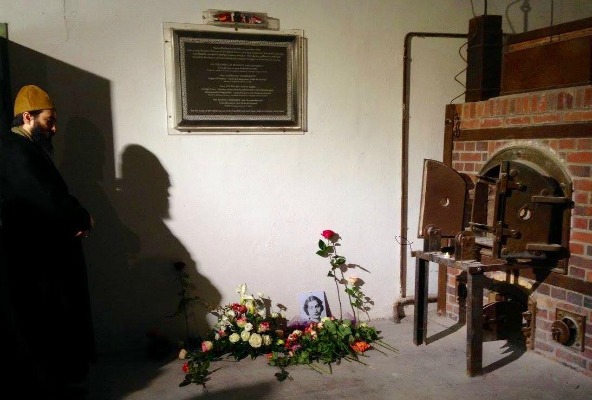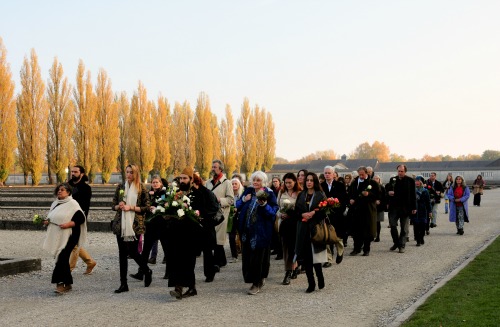01
2015A Visit to Dachau
By Humera Afridi
On the afternoon of October 26, a group of nearly 70 gathered outside the information center at the Dachau Concentration Camp, 15 miles northwest of Munich. We were there to honor Noor-un-Nisa Inayat Khan—eldest daughter of Pir-o-Murshid Hazrat Inayat Khan—who was executed in Dachau on September 13, 1944. Twenty years ago, during his lifetime, Pir Vilayat conducted Bach’s B Minor Mass in Dachau, in remembrance of his beloved sister. Now, in the presence and company of Pir Zia, we joined together to celebrate Noor’s life by laying flowers beneath the plaque that commemorates her bravery, and, in the evening, convening at the Carmelite Convent for prayer; a musical recital of Noor’s songs, and readings of her poems and stories. At the convent, more pilgrims arrived to honor Noor; they filled the pews, and enlarged our gathering to over a hundred strong.

Tribute at the Crematorium. Credit: Heike Ruhland.
Noor-un-Nisa lived and died courageously for the cause of freedom and justice. Although a pacifist, Noor could not abide the growing injustices of the Nazi regime during World War II. She felt a spiritual duty to act. She joined the war effort and worked as a secret agent transmitting encrypted messages from Paris and its environs. A few days before Noor was to return to England, she was betrayed. When the Gestapo captured her, Noor was the last remaining link between Britain and the Resistance. Shackled for an entire year in a prison cell in Pforzheim, she endured immense hardships. Noor was transferred to the Dachau concentration camp where through the night, and into the early hours of September 13, 1944, she was tortured by an SS officer. Despite her tremendous ordeal, Noor refused to release any information that would endanger her colleagues. Her last word, before she was shot, was Liberté.
We stood beneath an overcast sky, each one of us clutching a rose. The brightness of the flowers was startling amid the expansive gray of the gravel, and the cement and cinderblock buildings. A heavy silence pervaded the grounds. Here, over 30,000 documented deaths occurred and thousands more went undocumented. The absence of these many souls felt close, hovering above and around us, a living presence, as we formed a quiet procession behind Pir Zia, and crossed the threshold of the black iron gate engraved with the formidable message: Arbeit macht frei (Work shall set you free).

Procession. Credit: Josef Ries.
We walked at a steady pace, past the empty rows where barracks once stood, and along the ditch lined with barbed wire fencing, where prisoners trying to escape were shot. We walked to the far end of the camp, crossed the stream, and turned into the courtyard of the crematorium building that houses the gas chambers and the ovens that incinerated the newly dead. Climbing the stairs of the crematorium, we turned right, and found ourselves in a chamber facing the ovens. An ever-deepening silence enveloped our group. There on the wall, immediately to the left of the entrance, is a plaque commemorating the four brave women officers of the Special Operations Executive of the British forces who were murdered in Dachau— Yolande Beekman, Madeleine Demarment, Noorunisa Inayat Khan and Eliane Plewman. Noor was posthumously awarded the Croix de Guerre and the George Cross for her heroic service during the war.
Pir Zia stepped forward and lay an arrangement of white and light pink roses beneath the plaque. Someone from our group placed a framed photograph of Noor on the floor, leaning it upright against the wall. One by one, we lay down our flower offerings. And after we had all done so, we gathered close, got down on bended knee, lay our right hands palm-up on our right knees in the chivalric fashion, and invoked, “Ya Noor!” Then, we prostrated, touching our foreheads to the ground. In reverence and humility, we bowed to Noor, and to the extraordinary courage and strength of the human spirit. The feel of that cool, hard ground on our foreheads—the very ground that held Noor—is engraved in our heart and memory. Closing with the Prayer for the Universel, we exited the crematorium in a hush of tears and whispered prayers. Once outdoors, we drank in the view of tall poplar trees, and sought comfort in the green life of the garden that has come into being in recent years.
In the evening, after dinner, we walked to the Carmelite Convent, located by the north wall of the concentration camp, all the while marveling at the moon, glowing silver and full. On moonlit nights, just like this one, Noor would be parachuted out on her assignments—how fitting then that moonlight harmonized its note to our remembrance!
The Carmelite Convent is a refuge of peace. It radiates healing into the surrounding spaces of the former concentration camp. Latifa Tanja Mancinelli who meticulously organized our day at Dachau, said, “The most beautiful thing for me in this process was the unconditional openness that we have received from the sisters of the Carmelite Convent. From the beginning they have made us feel we are really welcomed here.” Indeed, it was a gift to recite our Sufi prayers and remember Noor within the haven of this gracious church.
A rich program comprised of Noor’s songs, and readings of her stories and poems interspersed with remembrances brought us ever closer to the spirit of this gentle and powerful woman. With her beautiful and moving renditions on tanpura—that included Noor’s At Thy Feet O Madzub—Fereshta, the musician, transported us into the sphere of the soul.
Pir Zia’s opening remarks highlighted the important work of the Carmelite Sisters in Dachau, “where darkness is illuminated by light through prayer.” He spoke of how moved he was to be gathered here in remembrance of his aunt. “I say ‘remembrance’ although I never met her myself. I couldn’t meet her because she was taken from this world,” he said. “I believe that I have met her in another way. I feel that I met her this afternoon. And I feel that she is here now.”
Pir Zia shared stories of Noor that were told to him by his father, stories that exemplified her great love, her kindness, and selflessness. “When I contemplate her personality, I think especially of four qualities,” he said. “First she was a bridge between east and west. Her father was Indian and her mother American… Growing up she was taught Indian music and also Western classical music… Sometimes she wore a sari, more often she wore a skirt… I think also of her deep belief in magic. Her worldview wasn’t a cold mechanistic, rationalist, materialist world view. Her vision of life was magic; sacred… She understood the inner dimension of life, the power of the imagination… And then I think of her kindness. From the earliest childhood she was known to be a person of astonishingly complete kindness… She took under her wing those who didn’t fit in, those who were struggling, those who were wounded… Her fourth quality, that I perceive so powerfully, is her courage. She volunteered for the most dangerous assignment in the world… She was determined to fulfill her work no matter the cost.”
At an early age, Noor rendered the Buddhist legends, the Jataka Tales, for a western audience. In doing so, it was as if she inscribed her destiny, merging with the selflessness of her characters. Noor’s work continues today—bridging East and West in spoken and subtle ways. She streams in to our present, inspires us with her tenderness, her magic, and her courage. May we return, again and again, to remember and honor her great being, and to be kindled by her light.